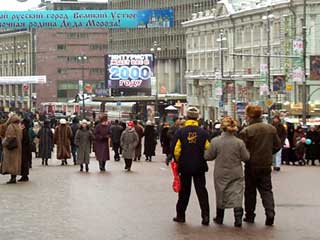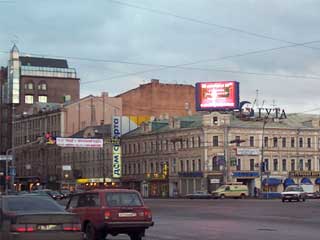Why is it preferable to choose large scale electronic screen?
The articles of our magazine are devoted to various issues of using electronic screens, to the latest technological developments in the area and our recommendations. Today we would like to draw your attention to some aspects of using large outdoor screens for outdoor advertising. We do not want to single out any particular type of systems (be it a lamp, LED, plasma or some other system) but to provide comprehensive information so that potential customers could select the one which is the most suitable for their purposes.
The main task of a large outdoor screen is to offer dynamic visual information for the maximum number of viewers. According to modern psychological studies, it is exactly the type of information that the human brain can absorb in unlimited quantities. Probably the best examples of using large electronic screens for outdoor advertising are the screens in North America (Nasdaq building, ITT Times Square – linear dimensions over 16x12 meters), in Moscow (Intourist hotel – linear dimensions 8x6 meters, 112x84 resolution), Yekaterinburg, Russia (linear dimensions 12x9 meters, 160x120 resolution).
American screens usually display not only commercial advertising but some important current information (e.g. stock and exchange rates etc.) as well as on-line advertising of Internet sites. Moscow screens recently started to advertise increasing numbers of Internet-projects, too. The screen in Yekaterinburg (which we introduced in our February #2/2000 issue) also became extremely popular. Citizen would gather around the screen to watch commercials. People recognized many commercials from previous TV broadcast but would admire them in their outdoor version greatly.
So, what are the criteria of success for outdoor advertising electronic screens?
- Proper location: all most successful screens are located on city main streets, on busy intersections; screens must be well seen from various points of approach.
- Proper selection of the screen size: size must be determined considering the average distance from which information could be seen and read.
- Proper selection of commercials: not everything fit for TV will show well on the outdoor screen.
Many people erroneously believe that an outdoor screen is similar to a TV and select common video commercials for large outdoor displays. However, they forget that commercials differ a lot. One may find wonderful commercials with large dynamically changing images. Such are some advertising clips of feature films, like “Romeo and Juliet”, “Gone in 60 Seconds”, “The Lake of Fear”, or commercials specially created for viewing on large screens, like Pall Mall cigarette slogan “Add fire to your night!” The reason maybe that producers hope to impress the audience with foreground images since the screens in cinema theaters are quite large. Moreover, the effect on viewers of awesome foreground image is believed to be lasting.
There exist numerous TV commercials that can be shown on large outdoor screens without any adjustments or editing (e.g. Nescafe and J7 Juice commercials etc.). However, our TV screens abound in commercials that are more fit for newspapers and magazines. These clips typically carry excessive minor details, inscriptions in small font, or long printed messages. No doubt, such pictures are good for unhurried viewing in a newspaper or magazine, but the message gets lost on a TV screen; in fact such commercials annoy viewers and become counterproductive. Naturally, if such commercial is chosen for the outdoor electronic screen, it should be thoroughly redone and re-edited.
Outdoor screens are extremely effective in showing dynamic advertising where none is expected. However it is wrong to ignore some peculiarities of outdoor advertising. The distance to passers-by or drivers is large, the changing light during the day may significantly affect the unsuitable picture, weather conditions affect perception, excessively fast-changing foreground and background images may create a flicker effect, etc. Not to forget that perception in the street and at home in a comfortable armchair is different.
However, an experienced professional can easily correct the situation. It is possible to incorporate special graphic methods to effectively utilize peculiarities of large outdoor screens:
- Avoid small details, small font letters and indistinct background images.
- Use bright saturated colors, avoid blurry pastel colors that can be negatively affected by direct sunlight or in gloomy and rainy weather.
- Use sharply delineated images, contrast must change during the day depending on the level of brightness outside.
To better understand peculiarities of video commercials on outdoor screens you can conduct a simple test. Put some attractive picture with some printed text on the screen of your computer and then get as far away as you can from the screen (maybe to the end of the room). You will immediately notice what remains visible and what disappears from the screen. So, considering this home test you can edit the image to make it more effective.
Creating a good well-visible commercial is only one factor in effective utilization of large outdoor screens. What is the use of creating a masterpiece that will remain unnoticed? Your commercial must be seen by the maximum number of people. Therefore, one of the main parameters to keep in mind is the overall display area. Therefore, the price of outdoor advertising installations (screens, billboards, roof constructions, etc.) depends on their total square area.
From the technical point of view other parameters may also affect the price. But professional advertisers know that it all boils down to advertising efficiency. That is why outdoor screens are becoming more and more popular in spite of their greater cost. The return on investment in electronic screens is significantly higher than in other advertising outdoor installations.
The advertising efficiency is calculated by the number of people who watch the screen. Thus, we come to the location parameter and display square area. The experience of advertizing agencies in North America, Russia and other countries demonstrate that the efficiency drastically increases when the area of screens exceeds 7x5 meters. In Japan first outdoor screens were all small. Recently all these installations were replaced by electronic screens with area not less than 70-100 square meters.
 |
 |
| Outdoor advertising lamp screen 8.54x6.4 m (Hotel “Intourist”, Moscow, Russia) |
Outdoor advertising LED screen 6x4 m (Belorussky square, Moscow, Russia) |
We have compared two screens located in similarly attractive sites:
- Lamp screen with 55 sq. m area (linear dimensions 8.54x6.4 m).
- LED screen with 25.6 sq. m (better resolution but linear dimensions 6.1x4.0 m).
The first screen attracted more customers and earned significantly more than the second. It turned out that advertisers are concerned mainly with the total audience of viewers. The information on the smaller LED screen could be viewed only from the distance of 40 meters; for drivers and their passengers the contact time is absolutely negligible (considering the car speed). Moreover, installed in the center of the city the screen was dominated by the surrounding huge buildings. As a result, its primary purpose of grabbing attention of viewers was mostly lost.
The second screen in our comparison (installed in Moscow near the Intourist Hotel) has the display area almost twice bigger – 55 sq. meters. Therefore, commercials become clearly seen from the distance of 100 meters, thus, significantly increasing the contact time and the potential audience. From the point of view of advertising agencies this is the factor that is worth the additional cost for the purchase of such screen. Again we want to stress that it is not important to see the screen but to see and read what is displayed on it! Here we have to ask ourselves a question. With the prices similar, which factor is more important: resolution of the image or linear dimensions of the screen?
Naturally, resolution is an important factor. It allows making images sharper and including more details in the picture. However in outdoor advertising the actual dimensions of image, printed words and telephone numbers appear to be of primary importance.
Let’s try another virtual experiment. Imagine that you place a TV (with extremely good resolution) on a 7-9 meter stand (or a roof of a 3-storied building). Then move away to consider its effect. With the good resolution and excellent brightness you may probably see the TV at the distance of 100-300 meters. However, you will not be able to discern the images or read printed messages until you return back to stand directly under it. So, what’s the use?
The conclusion is obvious. Dimension is more important than resolution. Moreover, the more dimensions of the screen, the better the resolution. Make your choice!
Thus, if you select the site for the screen, its height and linear dimensions correctly, and start creating commercials considering some peculiarities of outdoor environment, you will turn your screens into an effective and profitable advertising.





